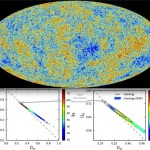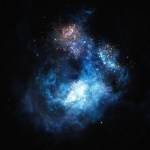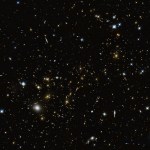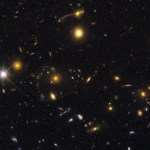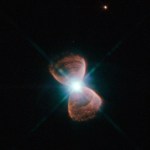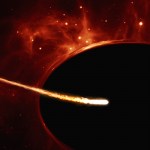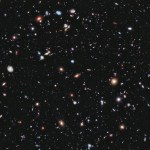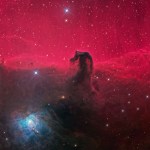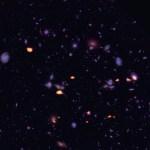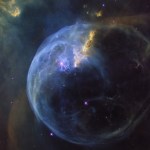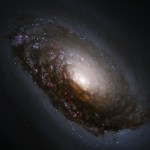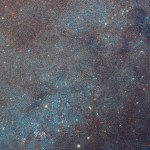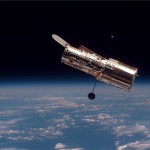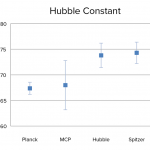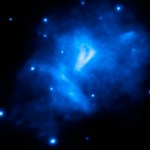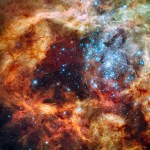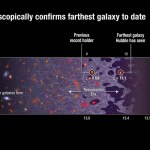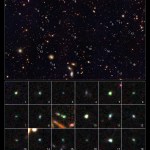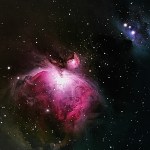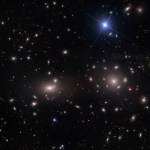Hubble
"In the far, far future, essentially all matter will have returned to energy. But because of the enormous expansion of space, this energy will be spread so thinly that it will hardly ever convert back to even the lightest particles of matter. Instead, a faint mist of light will fall for eternity through an ever colder and quieter cosmos." -Brian Greene
It seems like the simplest, most fundamental quantitative question about the expanding Universe of all: how fast is it expanding? Even though it's been more than 80 years since Hubble's most career-defining discovery, we still don't know the…
"...because that goal will serve to organize and measure the best of our energies and skills; because that challenge is one that we are willing to accept, one we are unwilling to postpone." -John F. Kennedy
The Hubble Space Telescope, for all of its scientific findings and how it revolutionized our understanding of the Universe itself, touched us all in a way that no piece of knowledge could ever encapsulate. In perhaps the greatest find of all, Hubble answered a question that many of us have had on our minds every time we've gazed up at a night sky: what does the Universe actually look…
“You may hate gravity, but gravity doesn’t care.” –Clayton Christensen
If all we had were galactic rotation curves -- like those measured by Vera Rubin -- we would know that something was wrong with our picture of the Universe, but we wouldn’t know how. Two equally good explanations, that there was either a flaw in the law of gravity or there was the existence of some unseen mass, could account for what we saw. But observations of galaxy clusters point to dark matter in a dramatic fashion.
The Coma cluster of galaxies, whose galaxies move far too quickly to be accounted for by gravitation…
“Deep into that darkness peering, long I stood there, wondering, fearing, doubting, dreaming dreams no mortal ever dared to dream before.” -Edgar Allan Poe
No matter where you look in the night sky, a powerful enough telescope appears to reveal points of light. Even if you find a region with no stars in the Milky Way, you’re likely to find thousands of galaxies in the deep sky beyond, as the Hubble Deep Field and successor images demonstrated. However, it wasn’t until 2010 and the WFC3 that we were able to get deep, wide-field views simultaneously.
A ground-based view of the region of sky…
"A bit of mould is a pleiad of flowers; a nebula is an ant-hill of stars." -Victor Hugo
In the distant future, about 7 billion years from now, our Sun will run out of all the nuclear fuel it’s capable of burning in its core. As it contracts under its own gravity, radiation becomes unable to hold it up any longer. Gravitation takes over, and the outer layers get blown off as the core contracts down into a white dwarf.
A star reaching the end of its life goes from fusing nuclei to blowing off its outer layers and contracting down. Image credit: NASA, ESA, and A. Zijlstra (The University of…
"Even with all the collected data we cannot say with 100% certainty that the ASASSN-15lh event was a tidal disruption event. But it is by far the most likely explanation." -Giorgos Leloudas
Last year, a record-shattering event occurred: we saw the brightest supernova ever observed in the Universe. It outshone the previous record holder by more than double, and it reached a peak brightness of more than 20 times the sum total of all the stars in the Milky Way galaxy. Surprisingly, it occurred in a red, quiet galaxy, rather than the bright blue ones famous for them. After 10 months of follow-up…
“Our posturings, our imagined self-importance, the delusion that we have some privileged position in the Universe, are challenged by this point of pale light. Our planet is a lonely speck in the great enveloping cosmic dark. In our obscurity, in all this vastness, there is no hint that help will come from elsewhere to save us from ourselves.” -Carl Sagan
How many galaxies are there in the observable Universe? If you had asked this question a century ago, the answer could have been anywhere from one to infinity. If you asked fifty years ago, we’d know the number was finite, since we knew about…
"If you are fearful, a horse will back off. If you are calm and confident, it will come forward. For those who are often flattered or feared, the horse can be a welcome mirror of the best in human nature." -Clare Balding
One of the most iconic astronomy images is that of the Horsehead Nebula. Located just off the easternmost star along Orion’s Belt, the Horsehead is remarkable for being a “dark” nebula rather than emitting or reflecting light on its own. This is due to its dust-rich nature and the background emission nebula, caused by bright, young stars that ionize the gaseous…
"We conducted the first fully blind, three-dimensional search for cool gas in the early universe. Through this, we discovered a population of galaxies that is not clearly evident in any other deep surveys of the sky." -Chris Carilli
The Hubble Ultra Deep Field and its successor images represent humanity’s deepest views of the stars in our Universe. But there’s more to the Universe than just stars; even the normal matter in the Universe is more commonly present in the forms of gas and plasma than in stars. Hubble can never image those so far away, since their wavelengths are too long. But the…
"Truth is tough. It will not break, like a bubble, at a touch; nay, you may kick it about all day like a football, and it will be round and full at evening." -Oliver Wendell Holmes
When isolated stars like our Sun reach the end of their lives, they're expected to blow off their outer layers in a roughly spherical configuration: a planetary nebula. But the most spectacular bubbles don't come from gas-and-plasma getting expelled into otherwise empty space, but from young, hot stars whose radiation pushes against the gaseous nebulae in which they were born.
The star powering…
"He ate and drank the precious Words,
his Spirit grew robust;
He knew no more that he was poor,
nor that his frame was Dust." -Emily Dickinson
When we look at spiral galaxies, we think of grand arms, star-forming regions and dust lanes lining our perspective. But unlike face-on galaxies, where everything looks the same, galaxies that appear tilted at an angle often appear to have one half far greater in its dust-richness than the other.
The Sunflower Galaxy, Messier 63, tilted relative to our line-of-sight, with one half clearly appearing dustier than the other. Image credit: ESA/Hubble…
“He who would search for pearls must dive below.” -John Dryden
If you want to know what types of stars are found all throughout a galaxy, looking at our own simply won't do: too much of it is obscured by the plane and our position within it. But there's an even more impressive galaxy -- Andromeda -- just 2.5 million light years away. And thanks to the power of the Hubble Space Telescope, we've not only resolved individual stars within it, we've resolved over a hundred million of them.
Closeup of a large region of the Andromeda galaxy's disk, containing hundreds of open star clusters (…
"In other words, theory attempts to segregate the minimum number of possible worlds which must include the actual world we inhabit. Then the observer, with new factual information, attempts to reduce the list further. And so it goes, observation and theory advancing together toward the common goal of science, knowledge of the structure and observation of the universe." -Edwin Hubble
To gaze into the empty abyss of deep space with the most expensive telescope of all requires a great leap of faith: that you’ll find something worth observing when you look. In 1995, the Hubble Space Telescope…
"That’s all regular matter, just five percent. A quarter is “dark matter,” which is invisible and detectable only by gravitational pull, and a whopping 70 percent of the universe is made up of “dark energy,” described as a cosmic antigravity, as yet totally unknowable. It’s basically all mystery out there - all of it, with just this one sliver of knowable, livable, finite light and life." -Summer Brennan
The Universe could have had any number of fates, even given that it started out with a hot Big Bang. Gravitation could have overcome the initial expansion, eventually causing a recollapse and…
"Every single time you make a merger, somebody is losing his identity. And saying something different is just rubbish." -Carlos Ghosn
A galaxy cluster is the largest individual bound structure in the Universe, containing anywhere from dozens to thousands of times the mass of our Milky Way. Yet as the cosmic web grows and evolves, many such clusters merge together, creating the largest cosmic trainwrecks in the Universe.
Image credit: NASA / STScI, of cluster MACS J0717.5+3745 in the optical, courtesy of Hubble Frontier Fields.
While very little evidence of a catastrophe is visible in the…
"The night has a thousand eyes, and the day but one;
Yet the light of the bright world dies with the dying sun." -Francis William Bourdillon
When we look for the brightest, bluest, most massive individual stars, we're restricted to looking nearby, since it's impossible to resolve individual stars at distances that extend much beyond our own galaxy. So how surprising is it, then, when the most massive stars we've ever found aren't in our own galaxy, nor in any of the monster galaxies we've found nearby, but in a small, satellite dwarf of our own: the Large Magellanic Cloud?
A combination…
"Our spectroscopic observations reveal the galaxy to be even farther away than we had originally thought, right at the distance limit of what Hubble can observe." -Gabriel Bremmer
One of the holy grails of cosmology is to measure, directly, exactly when the first stars and galaxies formed in our Universe. The Hubble Space Telescope has been pushing the distance record farther and farther back, with its measurements typically confirmed by ground-based, spectroscopic follow-ups. This time, however, the new record-holder was so distant that confirmation needed to be done from space: by Hubble…
"The wonder is, not that the field of stars of so vast, but that man has measured it." -Anatole France
If you could gather 250 million times as much light as your eye, and improve your resolution by several orders of magnitude, you just might be able to see what the Hubble Space Telescope can. By extending down into the near-infrared, and combining those observations with that from other great observatories like Chandra and Spitzer, we can probe the star-formation history of the Universe.
Image credit: NASA, ESA, the GOODS Team and M. Giavalisco (STScI/University of Massachusetts), of a…
"So numerous are the objects which meet our view in the heavens, that we cannot imagine a point of space where some light would not strike the eye;—innumerable stars, thousands of double and multiple systems, clusters in one blaze with their tens of thousands of stars, and the nebulae amazing us by the strangeness of their forms and the incomprehensibility of their nature, till at last, from the limit of our senses, even these thin and airy phantoms vanish in the distance." -Mary Fairfax Greig Somerville
The distant nebulae might appear to illuminate the night sky, but this neutral gas is…
"Gamow was fantastic in his ideas. He was right, he was wrong. More often wrong than right. Always interesting; … and when his idea was not wrong it was not only right, it was new." -Edward Teller
Considering what we know about our Universe today, it's hard to believe that just a century ago, Einstein's General Relativity was very much untested and uncertain, and we hadn't even realized that anything at all lie outside our own Milky Way. But over the past ten decades, ten great discoveries have taken place to give us the Universe we understand today.
Image credit: Adam Block/Mount…
